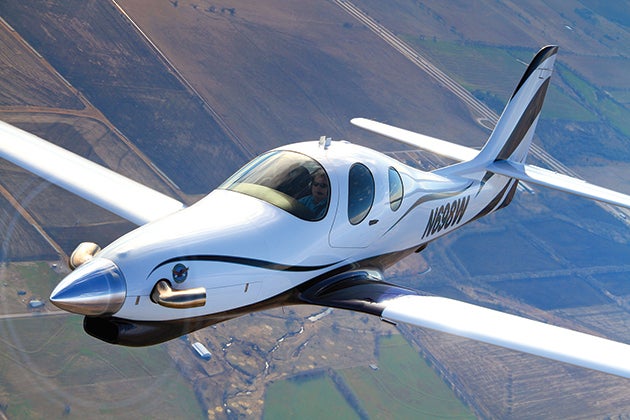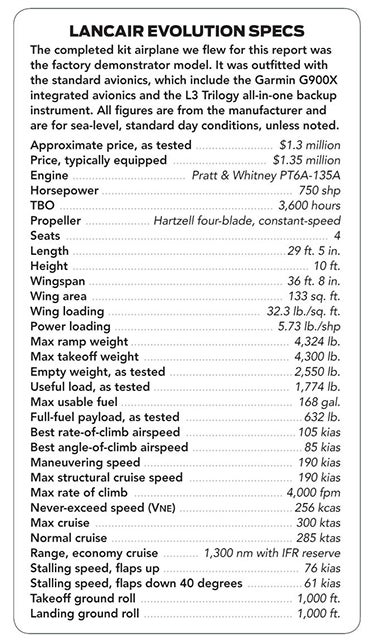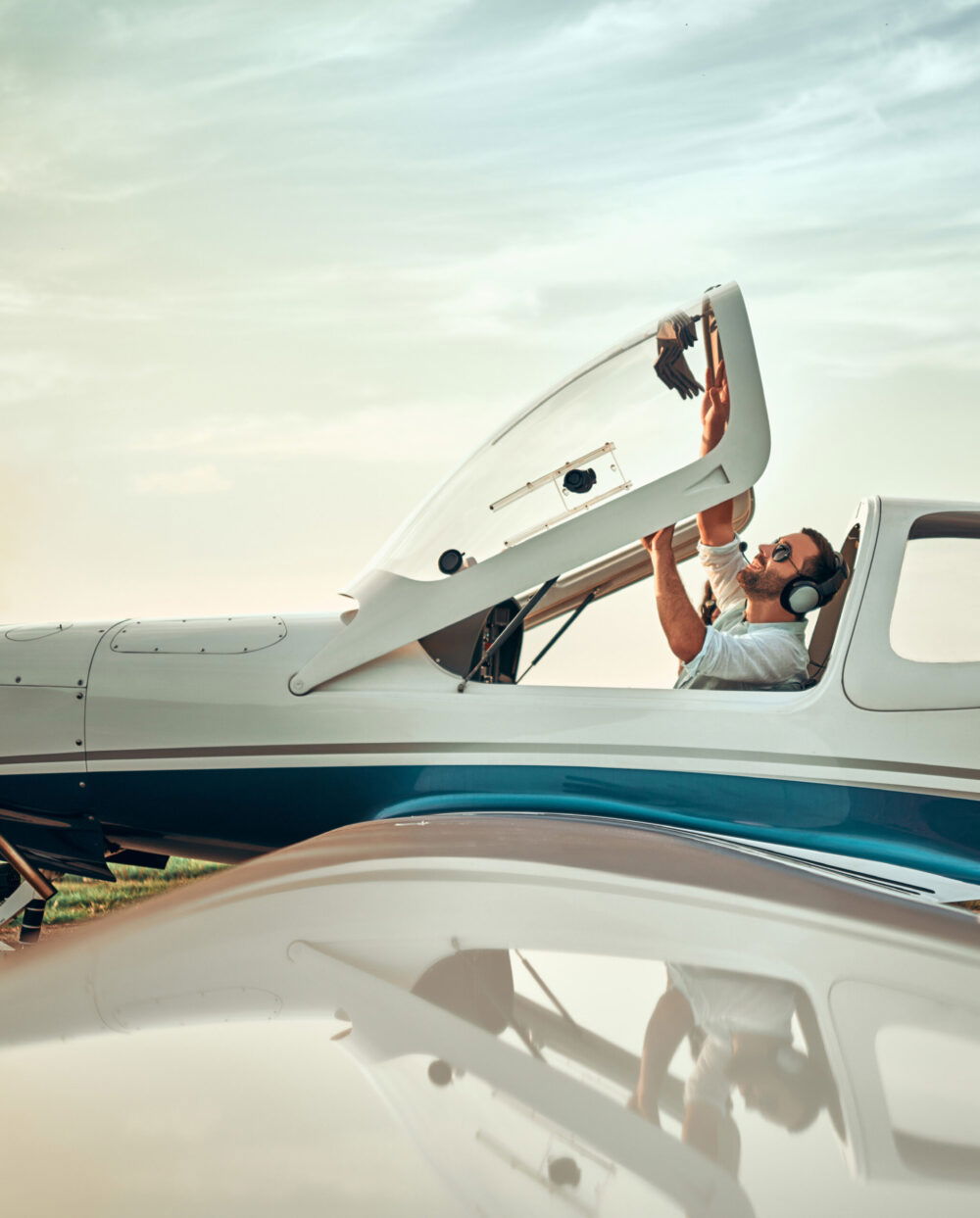You may think an airplane as complex as the Evolution doesn’t belong in the amateur-built world. But for a company like Redmond, Oregon-based Lancair International, which has decades of experience producing complex airplane kits, the concept makes total sense. With the Evolution, Lancair has incorporated Part 23 certification procedures into its successful kit business to produce predictable airplanes with the superb performance numbers Lancair customers have become accustomed to. And while the Evolution is the first Lancair designed without the company’s founder, Lance Neibauer, his tradition of producing fast-flying pieces of art continues.
The Lancair Evolution is a four-seat, all-composite, pressurized, high-performance, single-engine, turboprop-powered airplane. The Evolution brings a sleek carbon fiber airframe, benign stall characteristics, advanced systems and a powerful Pratt & Whitney engine providing reliability and performance.
The Evolution not only provides great speed — as fast as 300 knots at max cruise — it also has a wide flight envelope with a 61-knot stall speed, which is the FAA-mandated number for certificated single-engine airplanes. The benign stall characteristics have enabled the Evo to keep a clean accident record with at least 34 airplanes flying to date.
Being in the amateur-built category enables Lancair to provide all this at a previously unattainable price point, putting the airplane in its own niche. The catch is, the buyer gets to build the airplane — with a lot of help, it goes without saying.
The Evolution of Lancair
Since Neibauer launched his first Lancair airplane design in the early 1980s, the company has become known for its composite amateur-built kits. “They were out to build the best, highest-performing knots-per-horsepower airplane that they could build, and they did, absolutely hands-down,” said Lancair’s COO Tom Bowen. The pinnacle of that achievement is the Lancair IV-P, with a cruise speed as fast as 320 knots.
Although Neibauer’s family had a history with metal airplanes, specifically Meyers Aircraft, he was drawn to composites, perhaps because they enabled more streamlined, eye-catching shapes. Because in addition to providing speed, Neibauer wanted his airplanes to be beautiful, another goal he clearly achieved.
The early ’80s were the infant stages of using composite materials in airplane designs. Neibauer started his company in Santa Paula, California, but realized the environment for composite construction was optimal in the dry climes of central Oregon.
Lancair became very successful, with more than 2,000 kits sold and a long list of awards for Neibauer. Though Neibauer’s early days of kit production had little in common with the certified world, he decided to focus on certifying what later became the Lancair Columbia (now the Cessna Corvalis), and in 2003 the kit side of Lancair was sold to Wolstenholme Holdings and Joe Bartels, who also became the president and CEO.
The Evolution was introduced under the leadership of Bartels, but in the summer of 2010, Bob Wolstenholme took over as president and CEO. While Wolstenholme is clearly involved in the company’s decision-making process, Bowen, who came from Cessna/Columbia in 2006, manages the day-to-day operations.
Under Bowen’s leadership, operations have been transformed. “One of my biggest complaints when I first got here with the composite process was that very little was documented,” says Bowen. “There were almost no drawings of the parts, molds or ply schedules [the timing for the composite layering]. Everyone was doing it from memory.” Bowen drew from his extensive experience with Part 23 production, and the result is standardization and repeatability of production that enables a more predictable end product.
The materials that eventually become the Evolution fuselage arrive at the factory as sheets of pre-impregnated carbon fiber. Strict environmental conditions are crucial to the integrity of the material, which is why central Oregon, with its temperature and humidity profile and skilled workforce, is an ideal location for composite manufacturing.
Quality control is far beyond what you may expect from a “homebuilt” airplane factory. For example, all 355 composite pieces that make up the airplane are tagged with critical information and baked in computer-controlled ovens. Each piece is tap-tested, and if any potential flaws are found, ultrasound is used to troubleshoot the problem.
Evolutionary Design
While the Evolution benefits from the long history of Lancair, several things differentiate the airplane from its predecessors. It is the first Lancair completely designed using 3-D digital CAD (computer-aided design) software. The main benefit to this is consistency, said Bowen. CAD also enabled the Evolution’s low parts count and ease of assembly, and it helps with rapid prototyping for modifications or additions.

A major contributor to the Evolution’s performance qualities is the wing design. Far from amateur, the design was optimized using Xfoil analysis software and validated through wind tunnel testing. The wing is tapered and uses four different airfoils, resulting in “a balance of desirable flight characteristics tailored specifically for cruise performance, in-flight maneuvers, efficient climb and docile low-speed handling and stall behavior,” said Bowen.
Despite the advanced wing design, one fairly common complaint is that the Evolution’s roll control is heavy. And I agree that the pressure required to control the airplane is not balanced. The pitch control is nice, but when you need to roll the airplane, particularly at high speed, the amount of force required is excessive.
It is a problem Lancair decided to tackle. Bowen says the airfoil of the ailerons has been redesigned, and the trim tab has been moved to shift the center of pressure closer to the hinge line. “This will reduce the stick forces but retain the responsiveness at slow speed and flatten the ‘stick force per knot’ curve,” he said. While I cannot confirm this claim, the new ailerons are flying and should be available to new and existing customers this summer.
An electrical hot prop provides standard ice protection. An optional system is available for the wing and horizontal stabilizer through Kelley Aerospace’s thermal anti-ice/deice system, which also includes a glycol spray for the windshield. In addition, Lancair is developing a pneumatic deice system — boots — as a second option. To minimize the performance penalty, the boot will be fitted into a modified leading edge of the wing, as opposed to the existing leading edge, so it will not be a retrofittable option.
Underneath the wing, trailing link landing gear and a nitrogen oil strut absorb the energy during landings, making for silky-smooth transitions from air to ground.
In addition to exceptional strength and durability, one major benefit of carbon fiber construction, said Bowen, is the ease of creating an airtight pressure vessel. The composite parts, which are produced to very close tolerances, are bonded together with Hysol, a high-tech epoxy that forms a chemical and mechanical bond between each part, minimizing the possibility for leaks. Doors, doorsills, floors and closeouts are sealed with gaskets and inflatable door seals. The automatic pressurization system provides 6.5 psi of cabin pressure differential and enables an 8,000-foot cabin at 28,000 feet.
A 750 shp Pratt & Whitney PT6A-135A turboprop engine powers the Evolution, an engine with a very reliable track record. The Evo has also flown with a 350 hp Lycoming TEO-540; however, only the turboprop option is offered at this time.
Sidesticks on each side of the cockpit control the Evolution. This setup is, in my opinion, optimal because it is comfortable and it makes room for an electronic flight bag, kneeboard or whatever else you would like to have on your lap as you cruise along.
The Evolution’s EFC900X avionics suite includes Garmin’s G900X with synthetic vision and an integrated autopilot, a Radiant touch-screen environmental, pressurization and lighting control screen — and L3’s Trilogy electronic standby instrument.
Building the Evolution
So, with all these good qualities, is there a drawback? Well, there is one little snag. You have to build it yourself. The Lancair kit includes a highly organized, two-week, supervised build program at the factory in Redmond. At the completion of it, the carbon fiber fuselage is finished and sitting on the main gear. It may sound as if the airplane is almost ready to go, but there is still much work to be done.
Several commercial build shops can help complete the airplane. You may ask yourself how the owner/builder is able to meet the 51 percent rule while using commercial help, but the whole process is documented and broken down into tasks (not time) to satisfy the rule. If the owner can commit to one week per month after the initial two-week process, the airplane can be completed in six months. Most airplanes have taken about eight months to complete, however, said Lancair’s national marketing and sales director, Doug Meyer.
In dividing tasks between the manufacturer, commercial shop and owner/builder, Lancair focused on assigning jobs to the builder that are least critical to the safety of flight. For example, Lancair builds up the engine for the Evolution to ensure everything is set up properly. “The number-one leading cause of amateur-built accidents is improper engine and fuel setup, usually occurring in the first five hours of the airplane’s life,” said Bowen. Clearly, it is in Lancair’s best interest to prevent that as much as possible, and the purchase price also includes the first flight with a professional test pilot.
At $545,000, the kit itself includes every part required to build the Evolution, not including one minor detail: the engine. The choices for interior design, paint and creature comforts are limitless. When it is all said and done, the Evolution will cost the customer somewhere around $1.3 to $1.4 million, said Meyer.
With the poor accident record of the Lancair IV-P, the company’s previous generation pressurized model, getting affordable insurance was initially a problem for Evolution owners. Lancair solved this by educating underwriters about the airplane. Lancair provides an inspection of each airplane that results in a certificate of insurability. While the certificate doesn’t guarantee insurance, it assures insurance companies that the airplane meets Lancair’s specs.
Flying the Evolution
Having spent much time in another Lancair-developed model, the previously mentioned Cessna Corvalis, I quickly noticed that the cockpit layout is very similar to the Corvalis’, with the sidestick, Garmin G900X (the experimental world’s answer to the G1000) and the optional center column keypad, which operates some functions of the G900X.
The seats, which, by the way, come standard with seat heat, move forward and aft to place you in the optimal position to reach the stick while resting your arm on the armrest in the door frame. Short-legged people need not worry about reaching the rudder pedals, because they also adjust.
The cabin is roomy with plenty of leg and shoulder space for the front and rear occupants. The rear seats have quick-release knobs that allow removal of one or both of the seats should the owner want to carry cargo instead of passengers. But, with a volume of 39 cubic feet and weight limit of 225 pounds, the luggage compartment is likely sufficient in most cases.
Each airplane is different, but with heavy interior enhancements and multiple layers of paint, the empty weight was 2,550 pounds on the demo airplane I flew, providing a payload of 632 pounds. Meyer anticipates a gross weight increase, which would bring the payload up on a loaded airplane to 800 pounds.
Despite the wide beam between the large windshield and the side windows, I found the visibility to be very good all around from the front seat. However, rear passengers need to lean just slightly aft in order to see well through the side window.
I was able to taxi the airplane by simply pushing the rudder pedals and moving the throttle into beta if the airplane picked up too much speed. Very rarely did I touch the brakes.
With Meyer by my side, I did a rolling takeoff, which took up no more than 1,500 feet of runway on the takeoff run. Using a cruise climb of 140 knots, burning 45 gph, we reached our cruise altitude of FL 250 13 minutes after our departure from Redmond (KRDM), having leveled off briefly at FL 230. So Lancair’s claim of 12 minutes to its max altitude of 28,000 feet is realistic.
The 300-knot speed is also attainable. Burning 35 gph of jet-A in cruise, we saw 286 knots TAS. With slight assistance from the wind gods, we made the approximate 630 nm journey to Santa Monica in two hours and 20 minutes, and the 168-gallon fuel tank would have allowed us to continue flying for about another one and a half hours with reserves.
You can also bring the power back to extend the range. Doug Walker, the Northeastern sales representative, flight plans for 285 knots at 28,000 feet, burning 33 gph. In that case, your range would be well over 1,100 nm with IFR reserves.
At no point during the flight did I experience any pressure changes, and at 25,000 feet, the environmental system was showing 7,500 feet. Should you lose pressurization, there is an emergency backup oxygen system with basic masks that we kept plugged in and within reach. The Evolution’s rapid descent profile is impressive. With gear down and full flaps, we achieved a 4,500 fpm descent at 130 knots, trimmed out and hands off.

While roll control is very heavy at faster speeds, it is manageable during slower flight. At 16,500 feet, I tested the slow flight characteristics, which are incredibly stable. The stall, which happened at 62 knots, was just a slight, straight buffet.
From cruise, it is easy to bring the speed down to 160 indicated, put flaps down and fly the airplane at 140 knots, something you can do all day, if you wish to stay ahead of the airplane.
Approaching on final at 85 knots felt stress-free and, perhaps at least partially thanks to the unique landing gear system, my landing at Santa Monica Airport (KSMO) was silky-smooth.
I walked away from the Evolution with a big smile on my face. The performance qualities of the airplane are exceptional, and I like the concept of knowing my airplane as intimately as the builders do. The ability to fully customize the airplane is another benefit that doesn’t exist in the certified world. One interior installation shop is even adding air conditioning in the seats. The remarkable Evolution keeps evolving.




